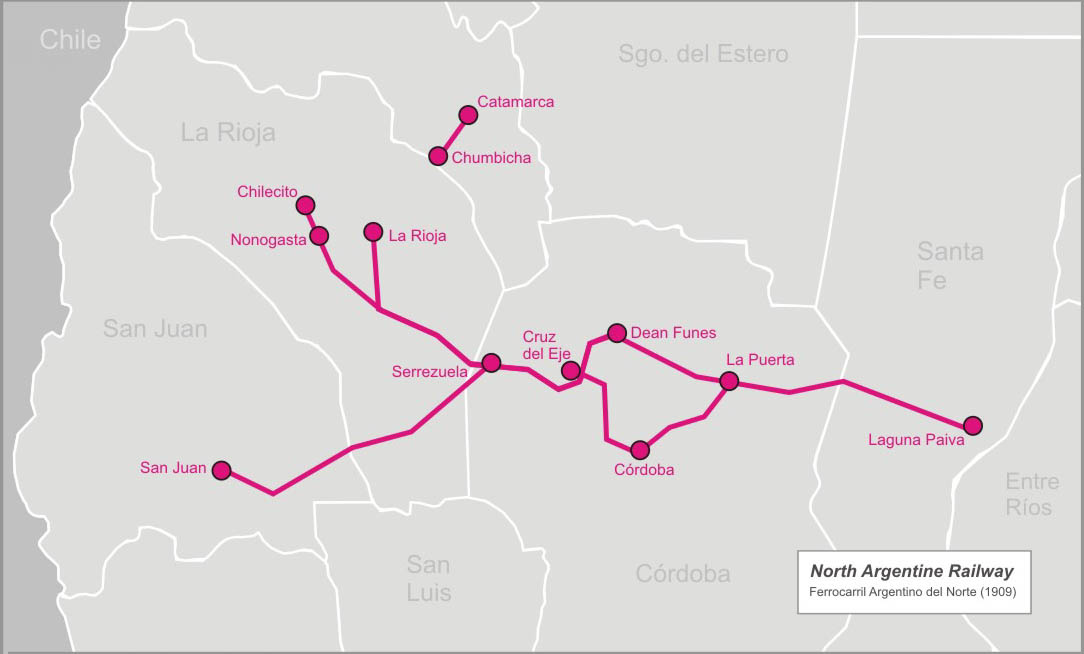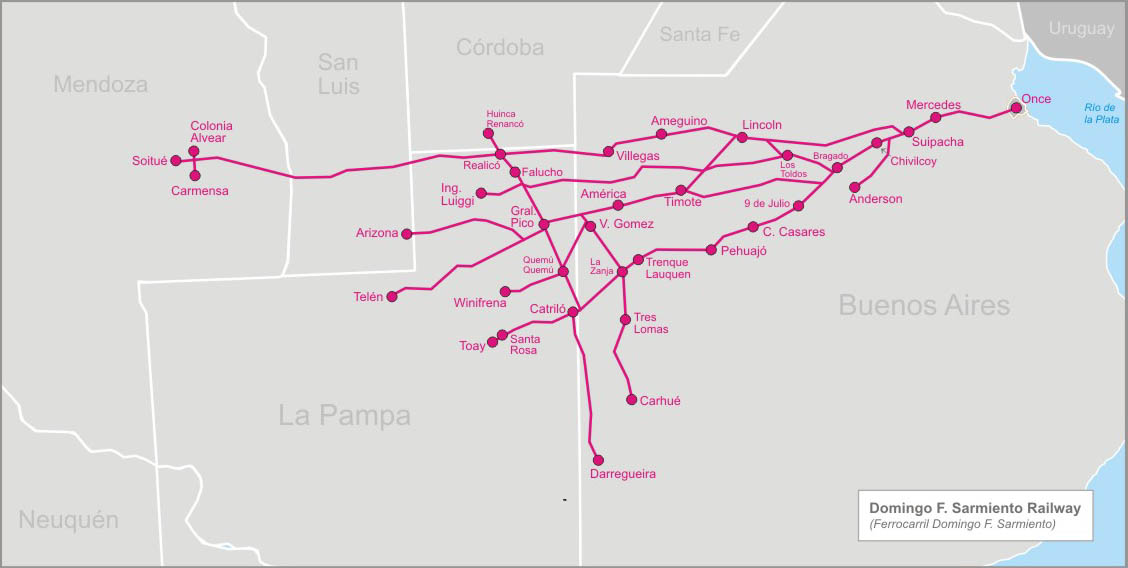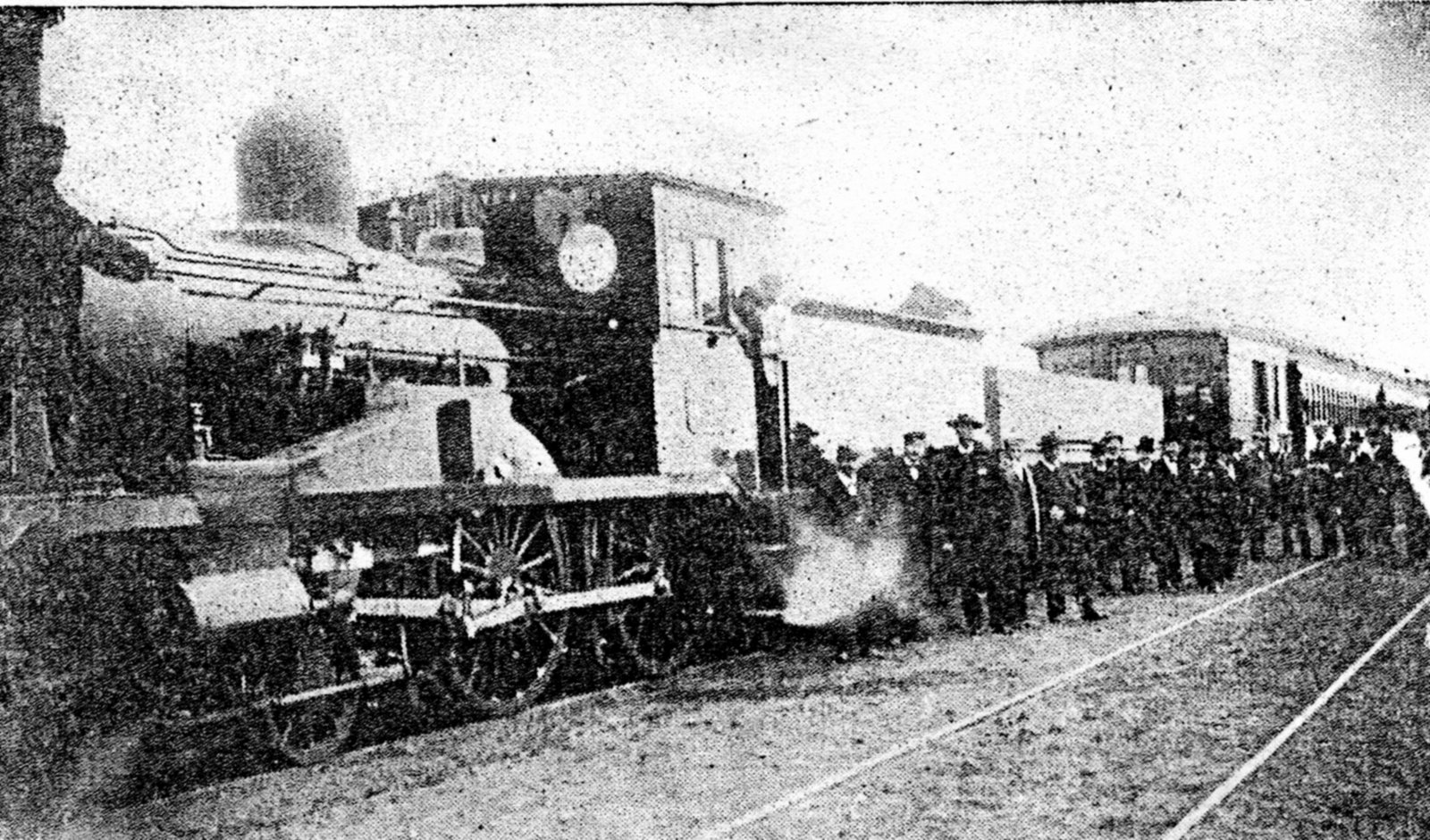|
Ferrocarriles Argentinos
Ferrocarriles Argentinos (abbreviated as FA; ) was a government-owned corporation, state-owned company that managed the entire Rail transport in Argentina, Argentine railway system for nearly 45 years. It was formed in 1948 when all the private railway companies were Railway Nationalisation in Argentina, nationalised during Juan Perón's first President of Argentina, presidential term, and transformed into the ''Empresa de Ferrocarriles del Estado Argentino'' (EFEA; ). FA managed both passenger trains, passenger and freight rail transport, freight services, including long-distance and commuter rail trains in the metropolitan area of Buenos Aires. The company was broken up under the government of Carlos Menem following the Railway privatisation in Argentina, privatisation of the railways; however in 2015 the government of Cristina Kirchner revived the brand for use on state-owned railways. [...More Info...] [...Related Items...] OR: [Wikipedia] [Google] [Baidu] |
Government-owned Corporation
A state-owned enterprise (SOE) is a business entity created or owned by a national or local government, either through an executive order or legislation. SOEs aim to generate profit for the government, prevent private sector monopolies, provide goods at lower prices, implement government policies, or serve remote areas where private businesses are scarce. The government typically holds full or majority ownership and oversees operations. SOEs have a distinct legal structure, with financial and developmental goals, like making services more accessible while earning profit (such as a state railway). They can be considered as government-affiliated entities designed to meet commercial and state capitalist objectives. Terminology The terminology around the term state-owned enterprise is murky. All three words in the term are challenged and subject to interpretation. First, it is debatable what the term "state" implies (e.g., it is unclear whether municipally owned corporations and ente ... [...More Info...] [...Related Items...] OR: [Wikipedia] [Google] [Baidu] |
Argentine North Western Railway
The Argentine North Western Railway (ANW) (in Spanish: Ferrocarril Noroeste Argentino) was a British-owned railway company, founded in 1886, that operated a railway network in the Tucumán Province of Argentina Argentina, officially the Argentine Republic, is a country in the southern half of South America. It covers an area of , making it the List of South American countries by area, second-largest country in South America after Brazil, the fourt .... The company was sold to the British-owned Córdoba Central Railway (CC) in 1899. History The company was founded in 1886 to acquire a concession, granted to Samuel Kelton in 1885 by the provincial government of Tucumán, for the construction of a 142-km line from Tucumán south to La Madrid, and for the building of 35 km of branch lines, including one from Concepción to Medinas, in the sugar growing region of the province. The line from Tucumán to La Madrid was completed in September 1889. It would be also know ... [...More Info...] [...Related Items...] OR: [Wikipedia] [Google] [Baidu] |
Ferrocarril Central De Buenos Aires
The Buenos Aires Central Railway (BACR) (in Spanish: Ferrocarril Central Buenos Aires) was an Argentina, Argentine railway company which built and operated a railway line from Buenos Aires to the city of 4 de Febrero in Santa Fe Province, Santa Fe. History On 2 October 1884 entrepreneur Federico Lacroze was granted a concession to build a 47 km Horsecar, horse-drawn railway from the Chacarita station of Buenos Aires (later demolished and replaced by Federico Lacroze railway station, Federico Lacroze terminus) to Pilar, Buenos Aires, Pilar. On 6 April 1888 the line was opened by the "Tramway Rural" company and was extended by 53 km to Zárate, Buenos Aires, Zárate on 27 July of the same year. From 1891 the company was allowed to operate trains using steam locomotives. The BACR also planned to extend the line across the Santa Fe Province with the aim of reaching Villa María, Córdoba, Villa María in Córdoba, but due to World War I the company could not import the ... [...More Info...] [...Related Items...] OR: [Wikipedia] [Google] [Baidu] |
Ferrocarril Argentino Del Norte
The North Argentine Railway (native name: Ferrocarril Argentino del Norte) was a State-owned railway company which built a (metre gauge) railway network in the Argentine provinces of Catamarca and Córdoba which was later merged with the state-owned Ferrocarril Central Norte in 1909. On 8 June 1889 a line between Chumbicha and Catamarca in Catamarca Province was opened by the state-owned company "Ferrocarril Chumbicha a Catamarca". Another state company, "Ferrocarril Deán Funes a Chilecito", completed a line between Deán Funes and Paso Viejo on 29 March 1890. The line was then extended to Patquia and finally to La Rioja in 1897. On 1 January 1898 these two railway companies were renamed "North Argentine Railway" (NAR) and on 23 June of the same year the section from Patquia to Chilecito was opened. On 27 July 1904 the president of Argentina Julio Roca opened the sections into the Andes mountains to Andagala and Tinogasta. The section from Chumbicha to La Rioja was open ... [...More Info...] [...Related Items...] OR: [Wikipedia] [Google] [Baidu] |
Ferrocarril Andino
The Andean Railway (native name: Ferrocarril Andino) was a state-owned railway company in Argentina which, towards the end of the 19th century, built and operated a line connecting Villa María in Córdoba Province with the cities of Mendoza, San Luis and San Juan. The network was later sold to a number of British-owned railway companies. History The first plan to reach the Andes through railway had been carried out with a concession granted to Central Argentine Railway (CAR) and later with the project to make Buenos Aires Western Railway a trans-andean line. The aim of the railway was linking the three provinces of the Cuyo region, San Juan, San Luis and Mendoza with the city of Rosario, via the CAR. The AR was the first state-owned railway in Argentina and was founded on 15 November 1867 by decree promulgated in November 1867, from Villa María to Villa Nueva, then extending to Río Cuarto. At the beginning of 1870 the Government signed an agreement to British entr ... [...More Info...] [...Related Items...] OR: [Wikipedia] [Google] [Baidu] |
Ferrocarril De San Cristóbal A Tucumán
The San Cristóbal to Tucumán Railway (in Spanish: Ferrocarril San Cristóbal a Tucumán) was a French-owned railway company founded in 1888 which built a railway from San Cristóbal to Tucumán in Argentina. History Originally granted in concession to Portalis frères, Charbonnier & Co. on October 21, 1887, it was transferred to Fives-Lille company one year later and transferred again to "Compagnie française des Chemins de Fer en Argentine" (colloquially known as ''La Francesa'') in July 1889, which finally built the rail line. The section from San Cristóbal in Santa Fe Province to Fortín Inca, just over the border in Santiago del Estero Province, was opened on 27 April 1891. From there construction continued across the province and into neighbouring Tucumán Province where San Miguel de Tucumán San Miguel de Tucumán (), usually called simply Tucumán, is the capital and largest city of Tucumán Province, located in northern Argentina from Buenos Aires. It is ... [...More Info...] [...Related Items...] OR: [Wikipedia] [Google] [Baidu] |
Ferrocarril Rosario Y Puerto Belgrano
The Rosario and Puerto Belgrano Railway (, ) was a French-owned rail transport operations company which operated a broad gauge, , single track line between the cities of Rosario and Puerto Belgrano in Argentina. Puerto Belgrano, near the city of Bahía Blanca in Buenos Aires Province, is the main naval base in Argentina. The original idea behind the building of the railway was to link points that were closer to either Rosario or Bahía Blanca than they were to Buenos Aires, thereby taking traffic from the British-owned companies BA Great Southern and BA Western railways. History Background Since the line was constructed after many other east-to-west lines had already been laid, these were crossed by constructing a large number of bridges. The otherwise near level course of the line was broken, at intervals, by short sharp gradients and this had an effect on the type of locomotives that could be used. In spite of this, a considerable volume of goods and livestock traffic was c ... [...More Info...] [...Related Items...] OR: [Wikipedia] [Google] [Baidu] |
Ferrocarril Provincial De Santa Fe
Province of Santa Fe Railway (in Spanish: Ferrocarril Provincial de Santa Fe and in French: "Compagnie Française de Chemins de Fer dans la Province de Santa Fe") was a French-owned company that purchased a railway network built by the provincial government of Santa Fe in Argentina on 10 April 1900 and later extended to the provinces of Chaco and Córdoba. After railway nationalisation in Argentina in 1948, it became part of the state-owned company Belgrano Railway History Development The company had its origins in the signing of a contract between the Santa Fe Provincial government and John G. Meiggs Son & Co. for the construction of a line north from the city of Santa Fe in the direction of the agricultural colonies. The section from Santa Fe to Rafaela was opened on 1 July 1885 and from Rafaela to Lehmann on 1 May 1886. Later the same year branch lines were opened from Empalme San Carlos to San Carlos Sur on 1 July and from Santa Fe to Colastiné on 15 October, an ... [...More Info...] [...Related Items...] OR: [Wikipedia] [Google] [Baidu] |
Compañía General De Ferrocarriles En La Provincia De Buenos Aires
The Compañía General de Ferrocarriles en la Provincia de Buenos Aires (CGBA) (in French: "Compagnie générale de chemins de fer dans la Province de Buenos Aires") was a French–owned company, formed in 1904, which operated a metre-gauge railway network in Argentina. History In 1904 the company took over a concession to build lines between the ports of Buenos Aires and Rosario, and to La Plata, together with other branch lines in the west and south of Buenos Aires Province. These lines were built as detailed below: The company always faced tough competition from the various large British-owned railway companies operating in the Province who had already built lines in those areas where most profit was to be made. As a result of this competition, plans to build a line between Buenos Aires and Bahía Blanca and other branch lines were abandoned. When the Government of Juan Domingo Perón took over the railways in 1948, the CGBA became part of Ferrocarril Belgrano. In ... [...More Info...] [...Related Items...] OR: [Wikipedia] [Google] [Baidu] |
Buenos Aires Western Railway
The Buenos Aires Western Railway (BAWR; Spanish: Ferrocarril Oeste de Buenos Aires), inaugurated in the city of Buenos Aires on 29 August 1857, was the first railway built in Argentina and the start of the extensive rail network that was developed over the following years. The locomotive ''La Porteña'', built by the British firm EB Wilson & Company in Leeds, hauled the first train to travel on this line. The BAWR was one of the ''Big Four'' broad gauge, British companies that built and operated railway networks in Argentina. The route initially measured , stretching from Del Parque station (now the site of the Teatro Colón) to Floresta station, which at that time was located in San José de Flores village, but is now within Buenos Aires city limits. The rails were laid along what are now Lavalle, Enrique S. Discépolo, Avenida Corrientes, and Avenida Pueyrredón, and then followed the route of the current Domingo Sarmiento Railway line towards Floresta. Although the co ... [...More Info...] [...Related Items...] OR: [Wikipedia] [Google] [Baidu] |
Villa María And Rufino Railway
The Villa María and Rufino Railway (VM&RR) (native name: Ferrocarril Villa María a Rufino) was a Great Britain, British-owned company that, towards the end of the 19th century, built and operated a Indian gauge, broad gauge, , railway line in Argentina. History The VM&RR was granted a concession on 15 August 1887 to construct a 227 km line between Villa María, Córdoba, Villa María in Córdoba Province (Argentina), Córdoba Province, on the Central Argentine Railway (CAR), and Rufino, Santa Fe, Rufino in Santa Fe Province, on the Buenos Aires and Pacific Railway (BA&P). The section between Villa María and La Carlota, Córdoba, Argentina, La Carlota was opened on 26 October 1890 and from La Carlota to Rufino on 23 March 1891. The line passed through the developing grain zone, which lay between the main lines operated by the BA&P and the CAR, and became a valuable feeder for the former railway. At that time the VM&R provided farmers situated along its route with their on ... [...More Info...] [...Related Items...] OR: [Wikipedia] [Google] [Baidu] |
Transandine Railway
The Transandine Railway () was a combined Rack railway#Chile, rack (Rack railway#Abt, Abt system) and Rail adhesion, adhesion railway which operated from Mendoza, Argentina, Mendoza in Argentina, across the Andes mountain range via the Uspallata Pass, to Los Andes, Chile, Santa Rosa de Los Andes in Chile, a distance of 248 km. It was a part of the first rail route linking the southern Pacific Ocean, Pacific and Atlantic Ocean, Atlantic Oceans. The railway has been out of service since 1984, and has been partly dismantled. There has been talk about restoring the railway, but there is currently no indication of any restorative work underway. As of 2023, there are still freight train services between Los Andes and Río Blanco on the Chilean side running on the Transandine railway tracks. History Beginning and development The Transandine Railway was first projected in 1854, but the construction of the line came many years later. It was initiated by Juan and Mateo Clark, Chile ... [...More Info...] [...Related Items...] OR: [Wikipedia] [Google] [Baidu] |










